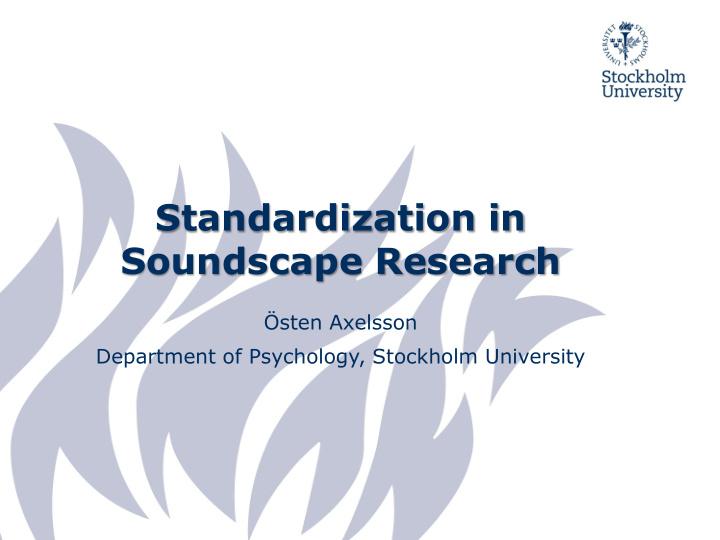



Standardization in Soundscape Research Östen Axelsson Department of Psychology, Stockholm University
ISO/TC 43/SC 1/WG 54 In 2008 the International Organization for • Standardization (ISO)decided to put together a new expert working group on soundscape The working group was named ”Perceptual • assessment of soundscape quality” 22/03/2010 / DAGA 2010, Berlin, Germany, 15-18 Mars 2010
Official of WG54 Convenor: Östen Axelsson, Stockholm University Secretary: Daniel Pérez Kaiser, German Standards (DIN) 22/03/2010 / DAGA 2010, Berlin, Germany, 15-18 Mars 2010
Soundscape An environment of sound (or sonic environment) • with emphasis on the way it is perceived and understood by the individual, or by a society Truax, B. (1999). Handbook for Acoustic Ecology (2 nd Ed.). Cambridge Street Publishing. 22/03/2010 / DAGA 2010, Berlin, Germany, 15-18 Mars 2010
Soundscape – a scarce resource Noise Control Soundscape Engineering Research sound is a waste sound is a scarce • • product to be recourse to be disposed of managed and designed promote quality of • aims to allow quality • life, health, and well- of life being 22/03/2010 / DAGA 2010, Berlin, Germany, 15-18 Mars 2010
Soundscape management Noise limit values [e.g., 55 dB(A) ] are • counterproductive Acoustic objectives: • – In this area transportations sounds must not be hear and natural sounds should dominate. – In this area care takers must be able to hear the sounds of their children at play 22/03/2010 / DAGA 2010, Berlin, Germany, 15-18 Mars 2010
Directive 2002/49/EC In determining noise limit values EU countries must • taking into account the need to preserve quiet areas in agglomerations, and aim to protect quiet areas against an increase in noise “quiet area in an agglomeration” shall mean an area, • delimited by the competent authority, for instance which is not exposed to a value of L den or of another appropriate noise indicator greater than a certain value set by the Member State, from any noise source “quiet area in open country” shall mean an area, • delimited by the competent authority, that is undisturbed by noise from traffic, industry or recreational activities 22/03/2010 / DAGA 2010, Berlin, Germany, 15-18 Mars 2010
Soundscape support to health The initiative to WG54 resulted from the Swedish • research program Soundscape support to health, 1999 – 2007 In this research program we aimed to understand • how people perceive soundscapes, and to develop new research tools The idea of an international standard for measuring • perceived soundscape quality evolved gradually 22/03/2010 / DAGA 2010, Berlin, Germany, 15-18 Mars 2010
Why standards? 1. Methods are needed for measuring soundscape quality 2. Existing acoustic metrics are not valid as indicators of soundscape quality 3. Knowledge and experience in evaluation of soundscapes is well developed 4. Standardized methods are needed for: a) compilation of knowledge (metaanalysis), b) harmonization of guidelines based on perception, c) evaluation and preservation of high soundscape quality 22/03/2010 / DAGA 2010, Berlin, Germany, 15-18 Mars 2010
Standards in perspective Compare with marketing research • There are no/few standards • Each marketing research company has its own • methods Comparison of results are impossible between • suppliers Customers are “locked - in” and it is hard to move • to a new supplier Marketing research companies are uninterested • in new research development 22/03/2010 / DAGA 2010, Berlin, Germany, 15-18 Mars 2010
WG54 an international cooperation Australia Norway • • Belgium South Korea • • France Sweden • • Germany United Kingdoms • • Italy United States of • • America Japan • 22/03/2010 / DAGA 2010, Berlin, Germany, 15-18 Mars 2010
Interdisciplinary approach Acoustics Psychology • • Architecture Sociology • • Epidemiology National Park • • Management Environmental • planning 22/03/2010 / DAGA 2010, Berlin, Germany, 15-18 Mars 2010
Scope of WG54 Provide minimum specifications for soundscape • studies Standard(s) will primarily be intended for • researchers and public users evaluating soundscape quality Standard(s) will include definitions, methods, • measurements and reporting requirements 22/03/2010 / DAGA 2010, Berlin, Germany, 15-18 Mars 2010
Soundscape methods for standardization Methods to assess perception/experience • Taxonomy and identification of specific acoustic • events Physical measurement: recording and analysis • Modeling, mapping and simulation methods • Soundscape design methods • 22/03/2010 / DAGA 2010, Berlin, Germany, 15-18 Mars 2010
Examples of applications Visitor questionnaire studies in outdoor areas • intended for recreation (e.g., city parks, or open green spaces) Resident questionnaire studies in residential • areas, including areas with designated places of high acoustic quality 22/03/2010 / DAGA 2010, Berlin, Germany, 15-18 Mars 2010
May soundscape methods be standardized? I propose a module approach • There are certain aspects of a soundscape that a • researcher like to evaluate – Sound source identification – Perceived overall soundscape quality – Preferences – Congruence with user objectives 22/03/2010 / DAGA 2010, Berlin, Germany, 15-18 Mars 2010
Sound source identification 22/03/2010 / DAGA 2010, Berlin, Germany, 15-18 Mars 2010
Overall soundscape-quality measurement 22/03/2010 / DAGA 2010, Berlin, Germany, 15-18 Mars 2010
Standards are not written in stone In ISO international standards are revised every • 5 years in order to be up to date with the latest development 22/03/2010 / DAGA 2010, Berlin, Germany, 15-18 Mars 2010
Future perspectives WG54 aims to propose the first international • standard on soundscape in the beginning of 2011 The standard is expected to be finalised in 2015 • In parallel to this process WG54 will propose • additional standards 22/03/2010 / DAGA 2010, Berlin, Germany, 15-18 Mars 2010
Questions oan@psychology.su.se 22/03/2010 / DAGA 2010, Berlin, Germany, 15-18 Mars 2010
Recommend
More recommend